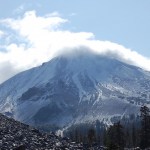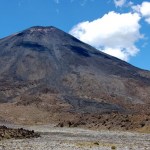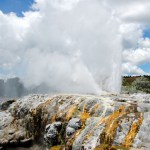New Zealand
I write frequently about naturopathy here because, of all the dubious pseudoscientific medical "disciplines" out there, naturopathy (along with chiropractic) has achieved the most "respectability." Indeed, as I like to point out in my own specialty (breast cancer), the Society for Integrative Oncology (SIO) even admits naturopaths as members. Indeed, the immediate past president of SIO is a naturopath (and, depressingly, faculty at my medical alma mater, the University of Michigan), as was the SIO president in 2014. So entrenched are naturopaths in SIO that they have been prominent co-authors…
In true MacGyver fashion, an employee at the Rainbow Springs Nature Park in New Zealand
repaired a damaged kiwi bird egg with masking tape thus protecting the chick from dehydration. The newly hatched bird was appropriately named Fissure.
Photo of Fissure from Rainbow Springs Nature Park.
"Let us leave this place where the smoke blows black
And the dark street winds and bends.
Past the pits where the asphalt flowers grow
We shall walk with a walk that is measured and slow,
And watch where the chalk-white arrows go
To the place where the sidewalk ends." -Shel Silverstein
No, there's not really an edge to our world, but if you've ever been to the ocean shores, you might know that feeling I'm talking about. The smell of the salt water, the wind gusting in from the sea, the sandy beaches and rocky outcrops slowly losing ground to the relentless waves; it's one of the most…
Quiet weekend on the whole, volcano-wise, beyond the articles about the latest eruption at Karangetang. So, we'll start this week with a new Mystery Volcano Photo. The last MVP was Tarawera in a shot I took from a road on the back side of the volcano, so that leaves the current standings looking like this:
Standings
Boris Behncke - 4
Don Crain - 4
The Bobs - 3
gijs - 2
volcanista - 1
Lockwood - 1
Elizabeth - 1
Ralph - 1
Anne - 1
Cam - 1
gg - 1
Damon Hynes - 1
Marco - 1
Doug C. - 1
Diane - 1
Stephen - 1
MK, Alberta - 1
Kultsi - 1
Henrik - 1
Zane - 1
Now, here is the new one. Good luck!
Click…
News for Monday!
Ngauruhoe in New Zealand, showing the dark lava flows of basaltic andesite on the slopes of the young volcanic cone. Image by Erik Klemetti, taken January 2009.
A couple pieces of news from two Russian volcanoes on the Kamchatka Peninsula: (1) last week's report of activity at Gorely appears to be semi-substantiated with new photos on the KVERT website (Russian). The images from June 6 and 12 (2010) shows steam plumes coming from the volcano - one as tall as 500 meters. Now, this doesn't imply that an eruption occurred, but it might suggest activity on on the upswing. KVERT…
The skeletons of female (larger, background) and male (smaller, foreground) Dinornis robustus, with a pigeon skeleton for comparison. From Allentoft et al 2010.
A little more than 700 years ago, multiple species of the gigantic, flightless birds called moas were still running around New Zealand. They ranged over almost the entirety of the North and South Islands, from the coast to the mountain forests, but when the Maori people arrived in the late 13th century the birds were quickly driven to extinction. Within a few hundred years they were entirely wiped out (along with the immense Haast…
Here it is, my attempt to recap a year's worth of volcanic events. By no means is this supposed to capture every event, but rather the highlight/lowlights and what most captivated me during 2009. I'll be announcing the winner of the 2009 Pliny for Volcanic Event of the Year tomorrow.
Waimangu Geothermal Valley in New Zealand, taken in January 2009 by Erik Klemetti.
January
The year started out with a trip to New Zealand (well, for me at least) and vistas of the Waimangu Valley, formed in the 1886 eruption of Tarawera on the North Island. We were also still thinking about the late 2008…
The evolutionary history of the extinct ratite moa and New Zealand Neogene paleogeography:
...We synthesize mitochondrial phylogenetic information from 263 subfossil moa specimens from across NZ with morphological, ecological, and new geological data to create the first comprehensive phylogeny, taxonomy, and evolutionary timeframe for all of the species of an extinct order. We also present an important new geological/paleogeographical model of late Cenozoic NZ, which suggests that terrestrial biota on the North and South Island landmasses were isolated for most of the past 20-30 Ma. The data…
One of the world's few flightless parrots, the Kakapo is endemic to New Zealand and is notable for having parrot sex with this guy's head.
This is basically Benny's dream date. Thanks to reader Heather H. for sending along.
tags: parrots, Kakapo, Strigops habroptilus, BBC Two, Last Chance to See, endangered species, BBC Two, Mark Carwardine, Stephen Fry, streaming video
Following in the footsteps of Douglas Adams, Stephen Fry joins Mark Carwardine to travel to some of the most remote places on earth in search of endangered animals. In this clip, Stephen Fry jokes about some of the names given to birds in New Zealand.
You might also be searching for this video: Shagged by a Rare Parrot.
I am very jealous of all you peeps who live in the UK: BBC Two is starting this series, Last Chance to See tomorrow! Alas, I…
Some brief notes before I dive headlong into the exciting world of faculty orientation!
A small steam plume coming from Turrialba in Costa Rica. Photo taken in August 2007.
There are some preliminary reports of the state of wildlife (and everything) around Kasatochi Island in the Aleutians from the US F&W and USGS team that headed to check out how the island has recovered since last year's eruption. The shoreline has been radically transformed by the ash and although some seabirds have made attempts to nest in the loose ash, it doesn't seem to have been very successful. However, not…
Pohutu Geyser in Rotorua, New Zealand. Image taken by Erik Klemetti in January 2009.
It has been busy busy week for me, capped off today with a talk about my field work in New Zealand (see above), so I don't have much to say. Not much new news today about the Saudi Arabian earthquake swarms, but again, I'll keep my eyes pealed (incidentally, I still haven't been able to figure out why no western news sources have even mentioned the swarm).
Anyway, here's are some volcanic tidbits to enjoy over the long weekend:
Vog, as seen from space. Volcanic fog, fashionably shortened to "vog" is a real…
For those of you looking to follow new cases (most of them suspected at this point, not confirmed), a great resource is HealthMap. Reports are popping up of possible infections worldwide: Scotland, Spain, Australia, and New Zealand. Certainly additional possible cases will be showing up over the coming days as well.
One thing I've seen mentioned (including here in the comments) is a question about the unlikelihood of a flu outbreak in Mexico in late April. Isn't influenza a cold-weather bug? Well, yes and no. Influenza circulates year-round at a low level, but it lasts longer in the…
Two tidbits from New Zealand:
- A recent survey of volcanoes in the Kermadec Arc north of New Zealand suggest that there is abundant - and recent - undersea volcanism. Scientists from University of Washington (one of my former homes) and Southhampton University (UK) explored a number of submarines volcanoes including Rumble II West, Rumble III and Brothers, which are all located along the same arc of volcanoes as New Zealand's own White Island and Mt. Edgecumbe. What they found was a change in the shape of Rumble III (1.4 km below the sea surface) since the last survey in 2007 - the summit…
Henry the Tuatara has recently knocked up one of his mates, Mildred, who's only 70-80 (scaaaandal!), in their museum enclosure/retirement complex at the Southland Museum on New Zealand's South Island. The couple now have a stack of 12 eggs.
Ladies, a little known fact about Henry...My dentures are removable. Yup, you heard me right.
Henry had shown little interest in reproduction since he arrived in the museum, a raucous young scamp of only 73. But after a recent bout of genital cancer was removed, he's back in the sack both figuratively and literally, and enjoying a healthy sex life with…
Fisherman hauled the world's largest squid ever caught out of the icy Antarctic waters last month. Since then, it has been kept on ice while scientists ponder how to prepare it for permanent display at the University of New Zealand. Larger than giant squid, colossal squid range from 40-65 feet long. This specimen weighed 1,090 lbs and was 33 feet long. Now the scientists have run into a problem: the frozen squid is so large that by the time the center of the beast defrosts, the outer flesh will have rotted.Colossal squid captured, mesonychoteuthis hamiltoni
The logical solution? Throw the…


